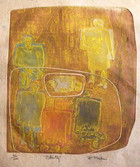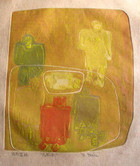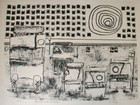Roland Poska
Anyone who has seen Roland Poska’s artwork will never look at paper the same way again! Since the 1960s, this Scottish-born artist of Lithuanian descent has been a true pioneer of paper art. Grinding together pulp and rags with a huge beater, he creates hand-made sheets for print-making, as well as bas-relief-like objects, dubbed “papestries,” built up from layers of his thick, fibrous paper mix, blended with color pigment.
Coming to the U.S. from Scotland by way of England and Canada, Poska, eventually, settled in Rockford, Illinois, where he established a print workshop in an old bakery in 1963, known as Fishy Whale Press. It soon attracted graphic artists from across the country, 14 of whose works were displayed at a 1972 exhibition at the Milwaukee Art Center. The show’s rough-textured paper catalogue cover in my collection was made by Poska, of course!
Poska describes his art as “deckle-edged,” referring to the uneven edges, or “deckles,” which form on hand-made paper. He sees these margins as creative spaces where “forces meet and grow.” I get some inkling of what Poska means in his two intaglio prints (in the original and second state), Nativity I and Nativity II, with their irregularly edged zones within zones. This really was a place in time, where forces met and merged, God and humankind, heaven and earth, and everything else implied by the doctrine of the Incarnation. With their uneven surfaces and deckles, these hand-made paper images should never be confined in frames under glass!
Poska presents a humorous, high tech version of the David and Goliath story in a lithographic study of contending robots, printed on conventional paper. In another lithograph, titled Jonah & the Whale, other kinds of forces meet and clash, as the reluctant Prophet lies uneasily beside his “host” fish, looking like he’s just been measured for a coffin. At least, the cancelling out of that harsh X by a delicately meandering spiral hints at the positive outcome to this fishiest of whale stories!





